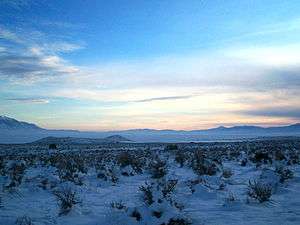Great Basin
The Great Basin is the part of the western United States that does not drain to the sea.
Understand
The Great Basin comprises most of Nevada and adjacent portions of eastern California, southeastern Oregon, southern Idaho, western Utah and southwestern Wyoming. Geographically, this region is bounded by the Sierra Nevada in the west, the Wasatch range in the east, the Columbia Plateau in the north, and the Mohave desert in the south. Central Wyoming's Great Divide Basin also does not drain to the sea, but is not considered to be part of the Great Basin.
The Great Basin is a high-elevation desert.
Cities
Major cities in the Great Basin include Reno, Carson City, and Salt Lake City. Boise lies just outside the Great Basin, in the Columbia River watershed.
Other destinations
Understand

The Great Basin is characterized by a series of north-south running mountain ranges separated by relatively flat basins. The highest peaks in these ranges are over 13,000 feet, while the lowest points in the basins are about 4000 feet. Due to the "rain-shadow" effect from the Sierra Nevada and the numerous mountain ranges in the basin itself, the Great Basin is very arid, with annual precipitation varying from approximately 4 inches per year to 10 inches per year, although the highest peaks can have significantly more precipitation. Most of this precipitation occurs in the form of snow in the winter, and is thus not available to plant life during the growing season. The predominant vegetation is sagebrush and shadscale in the lower elevations, dispersed Pinon-Juniper woodland at middle elevations, and Bristlecone and Limber Pine just below the alpine zone. Runoff collects in "playa" (dry lake-beds) or in a few cases year-round lakes and from there evaporates.
As well over 80% of the land in the Great Basin is publicly owned, opportunities for outdoor recreation are, quite literally, everywhere. Due to the region's remoteness and harshness, though, thorough planning is a necessity. Always bring reserves of fuel and water, and do not count on getting cell phone reception.
Get in
By plane
Major airports in the region are in Reno and Salt Lake City. Boise, which lies outside the geographic Great Basin, also serves portions of that region. Smaller airports are in Elko and Ely.
By train
Reno and Salt Lake City are both served by Amtrak.
Get around
To get anywhere in the Great Basin outside of the major cities will require a car. Four-wheel drive is not a necessity during the summer months, but a high-clearance vehicle is necessary for traveling to the remote areas.
See
- Berlin-Ichthyosaur State Park
- Lunar Crater
- Black Rock Desert
Do
Hiking
Interesting hikes in the Great Basin are plentiful. Water, rather than access, is generally the limiting factor. Many people limit themselves to a series of day-hikes rather than overnight trips in order to ensure water supplies. Aspen groves are a good indication of year-round water supplies, and in the autumn their golden leaves can be easily visible from a great distance.
See California desert camping for more advice.
- Arc Dome Wilderness Area
- Ruby Mountains
- Great Basin National Park
- White Mountains
- Mount Jefferson
- Mount Charleston
- Steens Mountain
- Deep Creek Mountains
- Schell Creek Range
Fishing
Native cutthroat trout are rare, but still found in remote streams and two large lakes. Most streams have been stocked with brook, brown and rainbow trout. These have become established and offer fishing for wild, but not native trout. In most of eastern Oregon's part of the basin, redband trout are the natives. These are closely related to rainbow trout, but are more vividly colored. Good places to try for native Cutthroats:
- Pyramid Lake
- Walker Lake
- Sheldon Wildlife Refuge
Eat
Drink
Stay safe
Go next